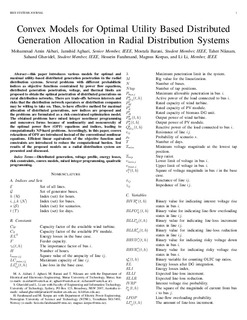| dc.contributor.author | Akbari, , Mohammad Amin | |
| dc.contributor.author | Aghaei, Jamshid | |
| dc.contributor.author | Barani, Mostafa | |
| dc.contributor.author | Niknam, Taher | |
| dc.contributor.author | Ghavidel, Sahand | |
| dc.contributor.author | Farahmand, Hossein | |
| dc.contributor.author | Korpås, Magnus | |
| dc.contributor.author | Li, Li | |
| dc.date.accessioned | 2019-04-30T10:58:03Z | |
| dc.date.available | 2019-04-30T10:58:03Z | |
| dc.date.created | 2018-12-01T00:26:26Z | |
| dc.date.issued | 2018 | |
| dc.identifier.citation | IEEE Systems Journal. 2018, 12 (4), 3497-3508. | nb_NO |
| dc.identifier.issn | 1932-8184 | |
| dc.identifier.uri | http://hdl.handle.net/11250/2596121 | |
| dc.description.abstract | This paper introduces various models for optimal and maximal utility-based distributed generation penetration in the radial distribution systems. Several problems with different probabilistic indices as objective functions constrained by power flow equations, distributed generation penetration, voltage, and thermal limits are proposed to obtain the optimal penetration of distributed generations on rural distribution networks. There are tradeoffs between interests and risks that the distribution network operators or distribution companies may be willing to take on. Thus, to have an effective method for maximal allocation of distributed generations, new indices are proposed, and the problems are formulated as a risk-constrained optimization model. The obtained problems have mixed-integer nonlinear programming and nonconvex forms because of nonlinearity and nonconvexity of the optimal power flow (OPF) equations and indices, leading to computationally nondeterministic polynomial-time-hard problems. Accordingly, in this paper, convex relaxations of OPF are introduced instead of the conventional nonlinear equations. Efficient linear equivalents of the objective function and constraints are introduced to reduce the computational burden. Test results of the proposed models on a radial distribution system are presented and discussed. | nb_NO |
| dc.language.iso | eng | nb_NO |
| dc.publisher | Institute of Electrical and Electronics Engineers (IEEE) | nb_NO |
| dc.title | Convex Models for Optimal Utility-Based Distributed Generation Allocation in Radial Distribution Systems | nb_NO |
| dc.type | Journal article | nb_NO |
| dc.type | Peer reviewed | nb_NO |
| dc.description.version | acceptedVersion | nb_NO |
| dc.source.pagenumber | 3497-3508 | nb_NO |
| dc.source.volume | 12 | nb_NO |
| dc.source.journal | IEEE Systems Journal | nb_NO |
| dc.source.issue | 4 | nb_NO |
| dc.identifier.doi | 10.1109/JSYST.2018.2808197 | |
| dc.identifier.cristin | 1637888 | |
| dc.description.localcode | © 2018 IEEE. Personal use of this material is permitted. Permission from IEEE must be obtained for all other uses, in any current or future media, including reprinting/republishing this material for advertising or promotional purposes, creating new collective works, for resale or redistribution to servers or lists, or reuse of any copyrighted component of this work in other works. | nb_NO |
| cristin.unitcode | 194,63,20,0 | |
| cristin.unitname | Institutt for elkraftteknikk | |
| cristin.ispublished | true | |
| cristin.fulltext | original | |
| cristin.qualitycode | 1 | |
